中医学英文词汇复习课程
中医基础英语(词汇+基础理论大段)

中草药Chinese medicinal herbs炮制processing四气五味four properties and five tastes清除杂质eliminating impurity入药部分the part used for medical purpose作用和缓mild effect药物采集collection of herbs发散解表relieving exterior syndrome by dispersion收敛astringency方剂学science of prescriptions软坚散结softening hardness to dissipate stagnation配伍关系compatibility燥湿健脾drying dampness and strengthening the spleen 组成规律prescription-formulating principle升降沉浮ascending, descending, sinking and floating 方剂的加减modification of prescriptions归经meridian tropism剂型和剂量drug form and dosage用药禁忌contraindication in using herbs君臣佐使monarch, minister, assistant and guide药物用量dosage药物毒性toxicity of medicinal herbs辛温解表药relieving exterior syndrome with herbs pungent in taste and warm in nature 十八反与十九畏eighteen incompatible herbs and nineteen herbs of mutual antagonism 袪风湿药herbs for expelling wind and dampness调和诸药moderating the property of herbs胸痛彻背thoracic pain involving the back温经散寒warming meridians to dissipate cold清热凉血药herbs for clearing away heat and cooling blood宣肺平喘disperse lung qi to stop asthma引经报使guiding action灵活化裁flexible modification针灸疗法acupuncture and moxibustion therapy, acumox清散郁热clearing away and dispersing stagnant heat针刺补泻reinforcing and reducing techniques for needling随症加减modification according to symptoms针刺手法needling techniques, manipulation药物饮片processed herbs进针手法methods for inserting the needle内服散剂powder for oral taking针刺止痛alleviating pain with acupuncture外用膏剂medicinal extract for exterior application针刺麻醉acupuncture anesthesia, acu-anesthesia开水冲服mixing in boiled water for oral taking针感needling sensation浓缩浸膏condensed extract皮内针intradermal needle耳针疗法ear acupuncture treatment针刺的角度与深度angle and depth of needling提插捻转lifting, thrusting, swirling and rotating双手进针法insertion of needle with double hands水针疗法hydro-acupuncture therapy行针manipulating the needle头针疗法scalp-acupuncture therapy化脓灸blistering moxibustion推拿手法manipulations for tuina, manipulating techniques 瘢痕灸scarring moxibustion减轻疼痛alleviating pain艾炷灸moxibustion with moxa cone功法训练exercise for practicing tuina灯火灸lamp moxibustion放松肌肉relaxing muscles温针灸warm needling method解除肌肉紧张relieving muscular tension一指禅推法pushing manipulation with one finger活动受限confined activity点按法point-pressing manipulation关节脱位dislocation of joint大鱼际揉法kneading manipulation with the large thenar医.学全.在.线网站 腰椎间盘突出protrusion of lumbar vertebral disc交替搓揉alternative rubbing and kneading旋转复位rotating reduction腰肌劳损injury of lumbar muscles软组织损伤injury of soft tissues解除痉挛relieving spasm关节粘连僵硬adhesion and stiffness of joint外感发热exogenous fever滑利关节lubricating joint脉象浮紧floating and tense pulse手法补泻reinforcing and reducing manipulations寒邪束表pathogenic cold hampering the exterior拇指平推法horizontal pushing with the thumb邪热入里interior invasion of pathogenic heat午后潮热afternoon tidal fever四肢厥冷cold limbs热扰神明heat disturbing mind阳气不振inactivation of yang-qi形体消瘦emaciation少气懒言lack of qi and no desire to speak祛痰止咳药herbs for eliminating phlegm and stopping cough中国医药学Traditional Chinese Medicine治未病prevention of disease中医基础理论Basic theory of traditional Chinese medicine 脏腑zang-organs and fu-organs, viscera临床经验clinical experience功能活动functional activities辨证论治treatment based on syndrome differentiation形神统一unity of the body and spirit本草materia medica, herbs阴阳失调imbalance of yin and yang中药Chinese materia medica, Chinese medicinal herbs条达舒畅free development四气五味four properties and five tastes延年益寿prolonging life, promising longevity针灸acupuncture and moxibustion, acumox养生防病cultivating health to prevent disease各家学说theories of different schools正气healthy qi, vital qi汗法diaphoresis, sweating therapy病邪pathogenic factor下法purgative therapy, purgation整体观念concept of holism吐法emetic therapy, vomiting therapy疾病的本质与现象nature and manifestations of disease补土派school of invigorating the earth阴阳的相对平衡relative balance between yin and yang病因学说etiology疾病的发生与发展occurrence and development of disease 养生health-cultivation,同病异治treating the same disease with different therapies医疗实践medical practice异病同治treating different diseases with the same therapy 治疗原则therapeutic principles五脏five zang-organs, five zang-viscera寒凉药物herbs of cold and cool nature, cold-natured herbs 六腑six fu-organs, six fu-viscera滋阴降火nourishing yin to lower/reduce fire经络系统system of meridians and collaterals滋水涵木enriching water to nourish wood余热未尽incomplete abatement of heat瘀血致泻disease caused by blood stasis有机整体organic wholeness/integrity先天之精congenital essence表里关系exterior and interior relation形与神俱inseparability of the body and spirit开窍opening into开胃promoting appetite自然现象natural phenomena脉象pulse conditions, pulse pattern哲学概念philosophical concept邪正关系states of pathogenic factors and healthy qi对立统一unity of opposites发热恶寒fever and aversion to cold相互消长mutual waning and waxing头身疼痛headache and body pain相互转化mutual transformation久痢脱肛proctoptosis due to prolonged dysentery阴阳属性nature of yin and yang养阴清热nourishing yin and clearing away heat相互联系interrelation清肺热clear away lung-heat相互制约mutual restraint, mutual restriction/interaction 湿邪犯肺pathogenic dampness invading the lung动态平衡dynamic equilibrium清热泻火clearing away heat and reducing fire阴平阳秘yin and yang in equilibrium腠理muscular interstices, striae, interstitial space阴阳的互根互用interdependence of yin and yang水湿停滞retention of water and dampness, water retention 相互依存interdependence癃闭retention of urine阴阳离绝separation of yin and yang气血运行circulation/flow of qi and blood相反相成opposite and supplementary to each阴阳转化transformation between yin and yang生理功能physiological functions阳消阴长yang waning and yin waxing病理变化pathological changes阴胜则阳病predominance of yin leading to disorder of yang 临床诊断clinical diagnosis阴胜则阳病an excess of yin leads to deficiency of yang阳胜生外热exuberance of yang leading to exterior heat阳胜则热predominance of yang generating heat阳中求阴obtaining yang from yin寒极生热extreme cold generating heat绝对偏盛absolute predominance热极生寒extreme heat generating cold阳虚则寒yang deficiency leading to cold阳损及阴impairment of yang involving yin阴阳俱损simultaneous consumption of yin and yang阴液不足insufficiency of yin-fluid阴阳两虚simultaneous deficiency of both yin and yang病机总纲general principle of pathogenesis阳虚发热fever due to yang deficiency病机pathomechanism, pathological mechanism阴阳自和natural harmony between yin and yang阴阳胜复alternative predominance of yin and yang木乘土the wood over-restrains the earth虚寒证deficiency-cold syndrome木火刑金wood-fire impairs the metal扶阳退阴strengthening yang to reduce yin金水相生generation between the metal and water祛风散寒expelling/eliminating wind to dispersing cold生克制化interrelationship between generation and restriction消导积滞promoting digestion and removing food retention制则生化restriction ensuring generation潜阳熄风suppressing yang to quench wind母病及子disease of the mother-organ affecting the child-organ五行学说theory of five elements传变transmission of disease, progress of disease运动变化motion and variation子病犯母disease of the child-organ affecting the mother-organ正邪相争struggle/combat between healthy qi and pathogenic factors 肝肾精血不足insufficiency of liver and kidney essence and blood 相生相克mutual generation and restriction肝阳上亢hyperactivity of liver yang生我,我生to be generated and to generate心肝血虚asthenia / deficiency of heart and liver blood克我,我克to be restricted and to restrict心肝火旺exuberance of heart and liver fire生中有制restriction within generation心火亢盛hyperactivity/exuberance of heart fire克中有生generation within restriction滋肾养肝nourishing the kidney and liver木曰曲直wood is characterized by growing freely and peripherally 方位配五行correspondence of the directions to the five elements 火曰炎上fire is characterized by flaming up温肾健脾warming the kidney and strengthening the spleen土爰稼穑earth is characterized by cultivation and reaping肾阳式微declination of kidney yang金曰从革metal is characterized by change脾阳不振inactivation of spleen yang病缓起gradual onset of disease脾胃虚弱hypofunction/weakness of the spleen and stomach肝阴不足insufficiency of liver yin地道不通menopause相乘相侮over-restriction and reverse restriction平肝和胃soothing the liver and harmonizing the stomach水湿停聚retention of water-dampness水火不济discordance between water and fire肾阴不足insufficiency of kidney yin藏象学说theory of visceral manifestations心肾不交disharmony between the heart and kidney奇恒之腑extraordinary fu-organs宣通水道dredging water passage水谷精微cereal nutrients, essence of water and food通调水道dredging and regulating water passage传化水谷transmission and transformation of food行气利水activating qi to excrete water贮藏精气storage of essence水液停滞retention of fluid治疗效果curative / therapeutic effect后天之本postnatal / acquired base of life藏而不泻storage without excretion调畅气机regulating qi activity泻而不藏excretion without storage肝气上逆upward flow of liver qi表热里寒exterior heat and interior cold水曰润下water is characterized by moistening and downward flowing肝旺脾虚hyperfunction of the liver and weakness of the spleen医.学.全.在线.网.站.提供脾主运化the spleen governing transportation and transformation大肉陷下obvious emaciation and muscular atrophy, extreme emaciation肝气郁结stagnation of liver qi面色红润ruddy complexion, rosy cheeks胆虚证gallbladder deficiency syndrome胆虚不得眠insomnia due to gallbladder asthenia腐熟水谷digesting food导便法laxation食欲不振poor appetite跌打损伤traumatic injury脘腹胀闷epigastric distension and depression动静结合integration of motion and quietness/stillness嗳气酸腐eructation with fetid odor定喘relieving asthma泌别清浊separating the clear from the turbid心主血脉the heart controlling blood and vessels食物残渣residue of food心气充沛abundance of heart qi大肠主传导the large intestine governing transmission and transportation 防御外邪入侵preventing the invasion of exogenous pathogenic factor 癃闭dysuria, retention of urine, anuria and dysuria血液充盈plenty of blood面黄肌瘦emaciation with sallow complexion脉道不利unsmoothness of vessels止珠偏斜strabismus, squint, ocular deviation面色无华lusterless complexion调节水液regulation of water脉象细弱thin and weak pulse排泄糟粕excretion of waste material面色萎黄sallow complexion髓海不足insufficiency of marrow-sea汗血同源sweat and blood sharing the same origin精神委靡dispiritedness, listlessness, lower spirit升降出入ascending, descending, coming in and going out 月经不调irregular menstruation气为血帅qi serves as the commander of the blood冲任不固weakness of thoroughfare and conception vessels 气血凝滞stagnation of qi and blood经期延长prolonged menstruation血瘀blood stasis小肠实热sthenia-heat in the small intestine气滞腰痛lumbago due to qi stagnation气机调畅smooth activity of qi气虚滑胎habitual abortion due to qi asthenia中医的基本特点The Basic Characteristics of TCM中医以整体观念和阴阳五行学说为指导思想和理论方法,以脏腑经络学说为理论核心,以辨证论治为诊疗方法。
中医英语文档
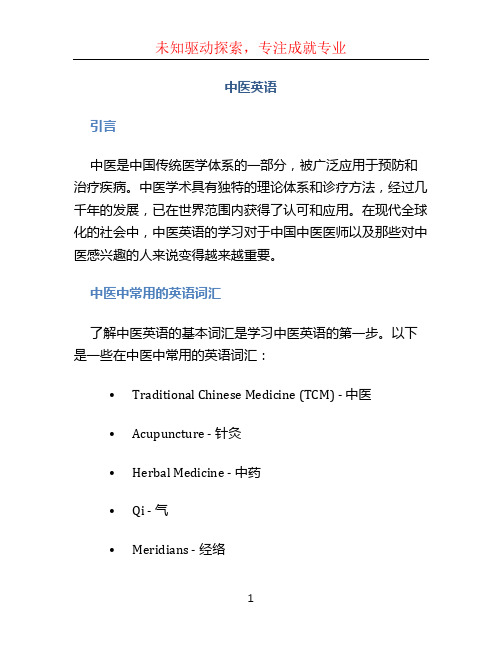
中医英语引言中医是中国传统医学体系的一部分,被广泛应用于预防和治疗疾病。
中医学术具有独特的理论体系和诊疗方法,经过几千年的发展,已在世界范围内获得了认可和应用。
在现代全球化的社会中,中医英语的学习对于中国中医医师以及那些对中医感兴趣的人来说变得越来越重要。
中医中常用的英语词汇了解中医英语的基本词汇是学习中医英语的第一步。
以下是一些在中医中常用的英语词汇:•Traditional Chinese Medicine (TCM) - 中医•Acupuncture - 针灸•Herbal Medicine - 中药•Qi - 气•Meridians - 经络•Yin and Yang - 阴阳•Five Elements - 五行•Diagnosis - 诊断•Treatment - 治疗•Moxibustion - 艾灸•Cupping - 拔罐•Tuina - 推拿这些词汇是中医英语学习的基础,掌握这些词汇将有助于更好地理解和学习中医理论与实践。
学习中医英语的方法学习中医英语的方法可以根据个人的学习习惯和需求来选择。
以下是一些常用的学习方法:1. 阅读中医相关的英文文献通过阅读中医相关的英文文献,可以了解到中医在国际上的研究和应用情况。
这不仅可以扩大中医的视野,还可以学习到更多的中医英语表达方式和专业术语。
2. 参加中医英语培训课程目前有一些机构提供中医英语培训课程,这些课程旨在帮助学习者更好地掌握中医英语,培养中医领域的英语表达能力。
通过参加这些课程,学习者可以学到专业的中医英语术语和表达方式,并且有机会与其他学习者一起进行交流和讨论。
3. 听力练习和口语训练通过听力练习和口语训练,可以提高中医英语的听说能力。
可以选择听一些中医英语的录音材料,如中医讲座或病例讨论,同时可以模仿并练习中医英语的口语表达。
4. 参与中医英语论坛和讨论参与中医英语论坛和讨论是锻炼中医英语写作能力的好方法。
可以加入一些中医英语的社群或在线论坛,与他人交流和分享中医知识,同时也可以提问和回答问题,提升自己的写作水平。
中医专业英语基础
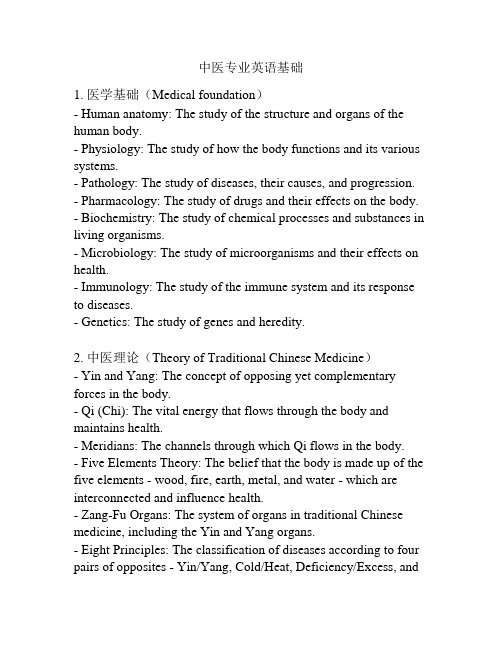
中医专业英语基础1. 医学基础(Medical foundation)- Human anatomy: The study of the structure and organs of the human body.- Physiology: The study of how the body functions and its various systems.- Pathology: The study of diseases, their causes, and progression. - Pharmacology: The study of drugs and their effects on the body. - Biochemistry: The study of chemical processes and substances in living organisms.- Microbiology: The study of microorganisms and their effects on health.- Immunology: The study of the immune system and its response to diseases.- Genetics: The study of genes and heredity.2. 中医理论(Theory of Traditional Chinese Medicine)- Yin and Yang: The concept of opposing yet complementary forces in the body.- Qi (Chi): The vital energy that flows through the body and maintains health.- Meridians: The channels through which Qi flows in the body.- Five Elements Theory: The belief that the body is made up of the five elements - wood, fire, earth, metal, and water - which are interconnected and influence health.- Zang-Fu Organs: The system of organs in traditional Chinese medicine, including the Yin and Yang organs.- Eight Principles: The classification of diseases according to four pairs of opposites - Yin/Yang, Cold/Heat, Deficiency/Excess, andInterior/Exterior.- Syndromes: The patterns in which symptoms present in traditional Chinese medicine, used for diagnosing and treating diseases.3. 中药学(Pharmacology of Traditional Chinese Medicine)- Traditional Chinese herbs: The various plants, minerals, and animal substances used in traditional Chinese medicine.- Herbal formulas: The combinations of herbs used to treat specific diseases or conditions.- Herbal identification and processing: The methods used to identify and prepare herbs for medicinal use.- Prescription and dosage: The principles and guidelines for prescribing and administering herbal treatments.- Toxicology: The study of the potential toxicity and side effects of traditional Chinese herbs.4. 中医诊断(Diagnosis in Traditional Chinese Medicine)- Observation: The examination of a patient's physical appearance, including the tongue, face, and body.- Listening and smelling: The assessment of a patient's voice, breath, and body odors.- Inquiry: The gathering of information about a patient's medical history, symptoms, and lifestyle.- Palpation: The use of touch to assess pulse, acupuncture points, and areas of tenderness.- Diagnosis methods: The different approaches used to diagnose diseases in traditional Chinese medicine, such as the Eight Principles, Five Elements, and Zang-Fu organs.5. 中医治疗(Treatment in Traditional Chinese Medicine)- Acupuncture: The insertion of thin needles into specific points on the body to stimulate Qi flow and balance Yin and Yang.- Herbal medicine: The use of traditional Chinese herbs in various forms, such as decoctions, powders, or pills, to treat diseases.- Tuina (Chinese massage): The manipulation of the body's muscles and soft tissues to promote circulation and relieve pain.- Cupping: The application of heated cups to the skin to create suction and promote blood flow.- Moxibustion: The burning of dried herbs (usually Artemisia vulgaris) near the skin to warm and stimulate acupuncture points. - Qigong: A combination of physical exercises, breathing techniques, and meditation aimed at cultivating Qi and improving overall health.6. 中医研究方法(Research Methods in Traditional Chinese Medicine)- Clinical trials: The systematic study of the safety and effectiveness of traditional Chinese medicine treatments in humans. - Pharmacological research: The investigation of the active components and mechanisms of action of traditional Chinese herbs. - Epidemiological studies: The analysis of disease patterns and risk factors in specific populations.- Case studies: The examination of individual patients' experiences and responses to traditional Chinese medicine treatments.- Experimental studies: The use of laboratory or animal models to investigate the effects of traditional Chinese medicine interventions.- Systematic reviews and meta-analyses: The synthesis of multiplestudies to evaluate the overall effectiveness of traditional Chinese medicine treatments.。
中医英语词汇汇总
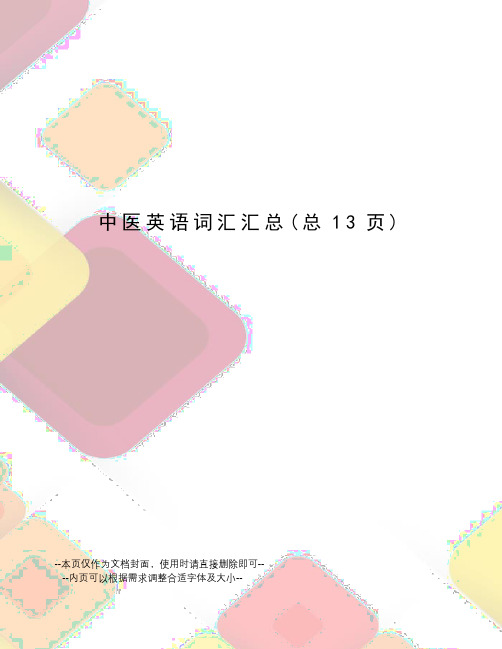
中医英语词汇汇总(总13页)--本页仅作为文档封面,使用时请直接删除即可----内页可以根据需求调整合适字体及大小--Lesson One History of Traditional Chinese Medicine中医术语acupunture and moxibusion 针灸health maintenance 养生drugs cold and cool 寒凉药the school of cold and cool 寒凉派diaphoesis emesis purgation 汗吐下the school of purgation 攻下派exagenous pathogenic factors 外邪reinforcing the earth 补土internal impairment of spleen and stomach would bring about vorious diseases 内伤脾胃百病由生yang is usually redundant ,while yin is frequently deficient.阳常有余阴常不足nourishing yin 滋阴medicinal herbs 草药blood stagnation 淤血warm and inorgorate the spleen and stomach 温养脾胃中国医药学: traditional Chinese medicine中医基础理论: basic theory of traditional Chinese medicine临床经验: clinical experience辨证论治: treatment based on syndrome differentiation; pattern identification and treatment本草: materia medica中药: Chinese materia medica; Chinese medicinals中草药: Chinese medicinal herbs四气五味: four properties and five tastes针灸: acupuncture and moxibustion各家学说: theories of different schools汗法: diaphoresis; sweating therapy下法: purgative therapy; precipitation吐法: emetic therapy; vomiting therapy补土派: school of invigorating the earth病因学说: etiology养生: health cultivation; health improvement; health preservation医疗实践: medical practice治疗原则: therapeutic principles寒凉药物: cold and cool medicinals滋阴降火: nourishing yin to reduce fire瘀血: blood stasis正气: healthy qi病邪: pathogenic factor整体观念: holism; holistic concept气血运行: circulation of qi and blood自然现象: natural phenomenaLesson Two Materialism and Dialectics in Traditional Chinese Medicine中医术语Materialism 唯物主义dialectics 辩证法celestial qi 天气terrestrial qi 地气the interaction between yin and yang 阴阳相互作用the lucid yang ascends to constitute the earth 清阳为天qi transformation 气化essence 精prenatal essence 先天之精shen(spirit) 神pathological factor 邪气the opposition and unity of yin and yang 阴阳对立统一the motion and changes of yin and yang 阴阳运动变化organic whole 有机整体Five kinds of visceral qi 五脏之气five emotional changes 五志excessive rage impairs the liver 怒伤肝excessive joy impairs the heart 喜伤心excessive meditation impairs the spleen 思伤脾excessive melancholy impairs the lung 悲伤肺excessive fright impairs the kidney 恐伤肾routine treatment and contray treatment 正治反治tit-for-tat(or blow-for-blow) 正治reinforcing therapy 补法purging therapy 泄法differential application and therapeutic methods 异法方宜mental activity 神志活动the heart is the king organ responsible for the activity of thinking consciousness 心为君主之官主神志意识will 意termed 志thinking 思wisdom 智summer-heat 暑热zheng qi ( healthy qi ) 正气Lesson Three The Basic Characteristics of TCMmaterilism and dialectics 唯物论和辨证法the concept of organic whole 整体观念treatment based on syndrone differentian 辨证论治drawing yin from yang 从阴引阳treating the nights for curing disease on the left 从右治左treating the same disease with different therapies 同病异治treating differnt disease with the same therapy 异病同治clear away fire in the heart 清心火sprouting occurs in spring ,growth in summer,transformationg in latesummer ,reaping in autumn andstoring in winter 春生夏长秋收冬藏the relation between pachogenic factors and healthy qi 正邪关系the four diagnosic methods 四诊purging the small intestine 泻小肠spring is usually marked by warrachs , summer by heat ,late summer by dampness ,autumn by dryness and winter by cold 春暖夏暑长夏秋燥冬寒the interstitial space are open when one swears clothes in summer天暑衣厚则奏理开哲学概念: philosophical concept对立统一: opposition and unity相互消长: mutual waning and waxing阴阳属性: nature of yin and yang相互转化: mutual transformation相互联系: interrelation相互制约: mutual restraint动态平衡: dynamic equilibrium阴平阳秘: yin and yang in equilibrium相互依存: interdependence阴阳的互根互用: interdependence between yin and yang阴阳离绝: dissociation of yin and yang阴阳转化: transformation between yin and yang阳消阴长: yang waning while yin waxing阴胜则阳病: predominance of yin leading to disorder of yang阳胜则热: predominance of yang generating heat寒极生热: extreme cold generating heat热极生寒: extreme heat generating cold相反相成: opposite and supplementary to each other生理功能: physiological functions病理变化: pathological changes临床诊断: clinical diagnosis阳胜生外热: exuberance of yang leading to exterior heat阳中求阴: obtaining yin from yang阳虚则寒: yang deficiency leading to heat阳损及阴: impairment of yang involving yin阴中之阳: yang within yin阴阳两虚: simultaneous deficiency of yin and yang阳虚发热: fever due to yang deficiency阴阳学说: theory of yin and yang症状与病名stomatitis 口腔炎 proctoptosis脱肛dysentery 痢疾hysteroptosis子宫脱垂measles 麻疹 ulcer溃疡the collapse of zhongqi 中气下陷Lesson Four The Theory of Yin and Yang中医术语相互消长:growth and decline between yin and yang阴阳属性:yin and yang properties相互转化:inter-transformation相互依存:interdependence between yin and yang阴阳的无限可分性:the infinite divisibility of yin and yang阴平阳秘:yang steadies while yin calms阳消阴长:waning of yang will lead to waxing of yin阳胜则热:predominance of yang gives rise to heat syndrome寒极生热:extreme cold brings on heat热极生寒:extreme heat brings to cold阴中之阴:yin within yin阳中之阳:yang within yang阴中之阳:yin within yang阳中之阴:yang within yin阴阳互根:interdependence between yin and yang阴阳自和:natural harmony of yin and yang春生sprouting in spring夏长growing in summer秋收reaping in autumn冬藏 storing in winter相互制约:mutual opposition and restriction between yin and yang动静升降出入motion and quiescence ,ascending and descending exiting and entering孤阳不升,孤阴不长if only yang exists ,there will be no birth,if only yin exists,there will be no growth .动态平衡 dynamic equilibrium阴胜则热excess of yang causing heat阴阳失调:imbalance between yin and yangyin-yang disharmony wiseman 02/ 谢竹藩04阴阳两虚 deficiency of both yin and yangdual vacuity of yin and yang wiseman 02阴阳乖戾 dysequilibrium between yin and yangying-yang imbalance 谢竹藩04阴阳离决 separation of yin and yangwhile yin is (exuberant)prevails, there is cold wiseman 02阳胜则热 when yang prevails, there is heat wiseman 02阳胜则阴病when yang prevails, yin ails wiseman 02阴胜则阳病when yin prevails, yang ails wiseman 02阳虚则外寒when yang is vacuous, there is external cold wiseman 02阴虚则内热 when yin is is vacuous, there is internal heat wiseman 02阴损及阳 detriment to yang affects yin wiseman 02阳损及阴exuberant yin repelling yang wiseman 02阴虚火盛exuberant yin vacuity fire wiseman 02 exuberance of fire/due to yin-deficiency 简明汉英中医词典2002李照国阴虚火旺 effulgent yin vacuity fire wiseman 02 yin vacuity fire effulgent wiseman 02yin deficiency with effulgent fire 中医药常用名词术语英译 2004。
中医英语课件整理
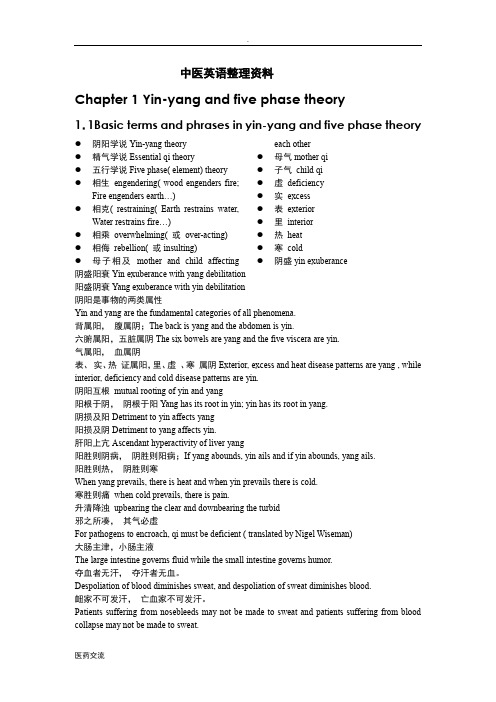
中医英语整理资料Chapter 1 Yin-yang and five phase theory1.1Basic terms and phrases in yin-yang and five phase theory●阴阳学说Yin-yang theory●精气学说Essential qi theory●五行学说Five phase( element) theory●相生engendering( wood engenders fire;Fire engenders earth…)●相克( restraining( Earth restrains water,Water restrains fire…)●相乘overwhelming( 或over-acting)●相侮rebellion( 或insulting)●母子相及mother and child affectingeach other●母气mother qi●子气child qi●虚deficiency●实excess●表exterior●里interior●热heat●寒cold●阴盛yin exuberance阴盛阳衰Yin exuberance with yang debilitation阳盛阴衰Yang exuberance with yin debilitation阴阳是事物的两类属性Yin and yang are the fundamental categories of all phenomena.背属阳,腹属阴;The back is yang and the abdomen is yin.六腑属阳,五脏属阴The six bowels are yang and the five viscera are yin.气属阳,血属阴表、实、热证属阳,里、虚、寒属阴Exterior, excess and heat disease patterns are yang , while interior, deficiency and cold disease patterns are yin.阴阳互根mutual rooting of yin and yang阳根于阴,阴根于阳Yang has its root in yin; yin has its root in yang.阴损及阳Detriment to yin affects yang阳损及阴Detriment to yang affects yin.肝阳上亢Ascendant hyperactivity of liver yang阳胜则阴病,阴胜则阳病;If yang abounds, yin ails and if yin abounds, yang ails.阳胜则热,阴胜则寒When yang prevails, there is heat and when yin prevails there is cold.寒胜则痛when cold prevails, there is pain.升清降浊upbearing the clear and downbearing the turbid邪之所凑,其气必虚For pathogens to encroach, qi must be deficient ( translated by Nigel Wiseman)大肠主津,小肠主液The large intestine governs fluid while the small intestine governs humor.夺血者无汗,夺汗者无血。
中医英语复习全攻略
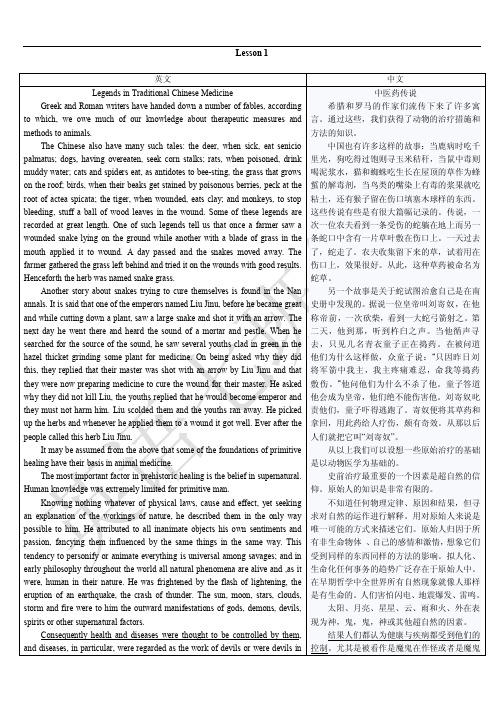
Lesson 1Lesson 2英文中文A comparison between Chinese and Western MedicineModern medical science is highly analytical and by reducing the body to its component parts, it devises appropriate therapy based on experimental studies of中西医区别现代医学科学是高度分析和减少身体的组成部分,它有效的治疗是建立在细菌学、5-15课part B 答案Lesson 51 2 3 4 5A C C DLesson 151 2 3 4 5A B C D C?Lesson 1中国医药学Traditional Chinese medicine中医基础理论basic TCM theory临床经验clinical experience辩证论治treatment based on syndrome differentiation 杂病miscellaneous diseases 中药学science of Chinese material medica 四气五味four properties and five flavors 针灸acupuncture and moxibustion中国古代哲学ancient Chinese philosophy病因学etiology方剂prescription医疗实践medical practice治疗原则therapeutic principle 寒凉药物herbs cold and cool in nature 滋阴降火nourishing yin and reducing fire 瘀血致病diseases caused by blood stasis1.中国医药学有数千年的历史,是中国人民长期同疾病作斗争的经验总结TCM has a history of thousand of years and is a summary of the Chinese people’s experience in their struggle against diseases.2.中医学有完整独立的理论体系。
《中医专业英语(一)》教学大纲

《中医专业英语(一)》教学大纲课程名称:中医专业英语(一)开课(二级)学院:外语教学中心课程性质:选修课学分:4分学时:56学时前期课程:中医英语基础授课对象:中医药类各专业(本科)考核方式:考试课程简介:本课程是以中医学专业知识和普通英语为基础的专业英语课。
课程主要内容包括中医基础理论英语表达、中西医文化差异、中医经典术语及常用短语翻译、中医门诊英语口语训练、中医药学科技讲座英语听力训练等内容。
本课程的教学目的是使学生了解和掌握中医英语翻译的基本方法与技巧,逐步具备运用专业英语从事医疗、科研及国际交流的能力。
This course is a specialized one based on common English and traditional Chinese medicine (TCM). Its main contents include the English expression of basic theories of TCM, the cultural differences between Chinese and Western medicine, the translation of classical terms and commonly used phrases in TCM, spoken English training for outpatient service, listening practice of TCM sci-tech lectures in English and so on. The purpose of the course is to train students to understand and master the basic methods and techniques of TCM English translation and acquire the professional English skills for taking part in the clinic and research work as well as international exchange.大纲内容一、前言【课程目的】本课程是以中医学专业知识和普通英语为基础的专业英语课,旨在培养和提高学生中医专业英语水平,掌握中医翻译的方法与技巧,逐步具备中医专业英语翻译能力,为进一步从事对外医疗活动以及国际学术交流奠定坚实的基础。
中医药名词英文翻译01(学科相关词汇)
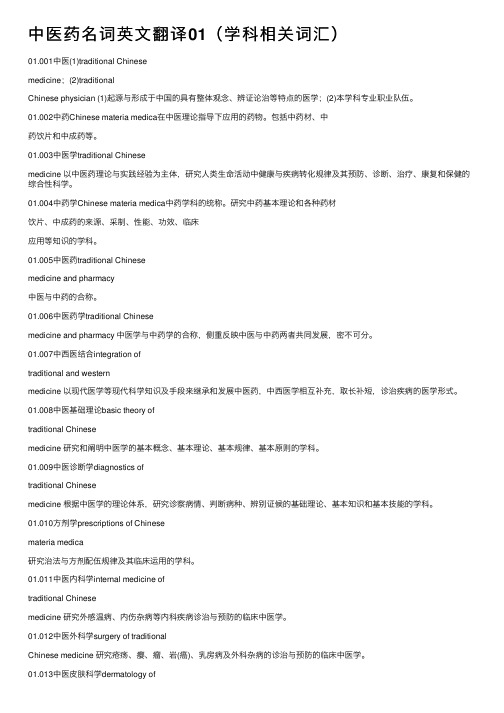
中医药名词英⽂翻译01(学科相关词汇)01.001中医(1)traditional Chinesemedicine;(2)traditionalChinese physician (1)起源与形成于中国的具有整体观念、辨证论治等特点的医学;(2)本学科专业职业队伍。
01.002中药Chinese materia medica在中医理论指导下应⽤的药物。
包括中药材、中药饮⽚和中成药等。
01.003中医学traditional Chinesemedicine 以中医药理论与实践经验为主体,研究⼈类⽣命活动中健康与疾病转化规律及其预防、诊断、治疗、康复和保健的综合性科学。
01.004中药学Chinese materia medica中药学科的统称。
研究中药基本理论和各种药材饮⽚、中成药的来源、采制、性能、功效、临床应⽤等知识的学科。
01.005中医药traditional Chinesemedicine and pharmacy中医与中药的合称。
01.006中医药学traditional Chinesemedicine and pharmacy 中医学与中药学的合称,侧重反映中医与中药两者共同发展,密不可分。
01.007中西医结合integration oftraditional and westernmedicine 以现代医学等现代科学知识及⼿段来继承和发展中医药,中西医学相互补充,取长补短,诊治疾病的医学形式。
01.008中医基础理论basic theory oftraditional Chinesemedicine 研究和阐明中医学的基本概念、基本理论、基本规律、基本原则的学科。
01.009中医诊断学diagnostics oftraditional Chinesemedicine 根据中医学的理论体系,研究诊察病情、判断病种、辨别证候的基础理论、基本知识和基本技能的学科。
01.010⽅剂学prescriptions of Chinesemateria medica研究治法与⽅剂配伍规律及其临床运⽤的学科。
(完整word版)中医英语期末复习
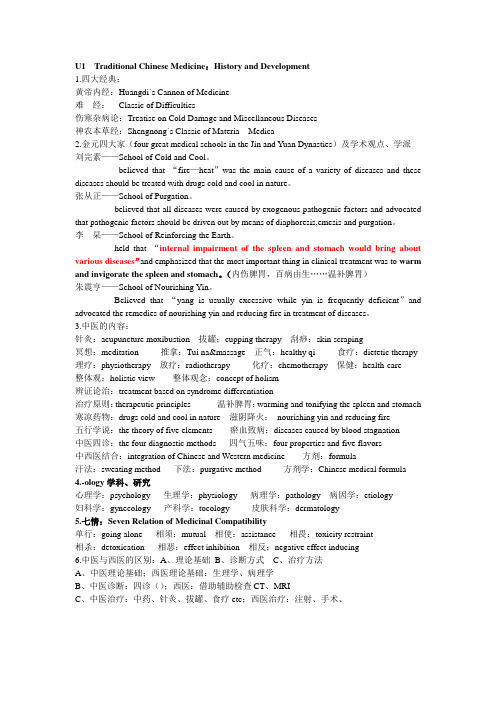
U1 Traditional Chinese Medicine:History and Development1.四大经典:黄帝内经:Huangdi`s Cannon of Medicine难经:Classic of Difficulties伤寒杂病论:Treatise on Cold Damage and Miscellaneous Diseases神农本草经:Shengnong`s Classic of Materia Medica2.金元四大家(four great medical schools in the Jin and Y uan Dynasties)及学术观点、学派刘完素——School of Cold and Cool。
believed that “fire—heat”was the main cause of a variety of diseases and these diseases should be treated with drugs cold and cool in nature。
张从正——School of Purgation。
believed that all diseases were caused by exogenous pathogenic factors and advocated that pathogenic factors should be driven out by means of diaphoresis,emesis and purgation。
李杲——School of Reinforcing the Earth。
held that “internal impairment of the spleen and stomach would bring about various diseases”and emphasized that the most important thing in clinical treatment was to warm and invigorate the spleen and stomach。
中医英文词汇

中医英文词汇1. 中医学(Traditional Chinese Medicine, TCM)2. 经络学(Meridianology)3. 气(Qi)4. 血(Xue)5. 阴阳(Yin-Yang)6. 五行(Five Elements)7. 经络(Meridian)8. 穴位(Acupoint)9. 针灸(Acupuncture)10. 拔罐疗法(Cupping Therapy)11. 刮痧疗法(Gua Sha Therapy)12. 中草药(Chinese Herbal Medicine)13. 草药学(Herbology)14. 方剂(Prescription)15. 药膳(Medicated Diet)16. 气功(Qigong)17. 太极拳(Tai Chi)18. 推拿按摩(Tui Na Massage)19. 中医诊断(TCM Diagnosis)20. 脉诊(Pulse Diagnosis)21. 舌诊(Tongue Diagnosis)22. 中医治疗(TCM Treatment)23. 经络按摩(Meridian Massage)24. 中医保健(TCM Wellness)25. 中医病因学(TCM Pathology)26. 中风(Stroke)27. 心血管疾病(Cardiovascular Disease)28. 消化系统疾病(Digestive System Disorders)29. 呼吸系统疾病(Respiratory System Disorders)30. 神经系统疾病(Neurological Disorders)31. 内分泌系统疾病(Endocrine Disorders)32. 妇科疾病(Gynecological Disorders)33. 男科疾病(Andrology)34. 儿科疾病(Pediatrics)35. 皮肤病(Dermatological Disorders)36. 风湿病(Rheumatological Disorders)37. 肿瘤学(Oncology)38. 精神疾病(Psychiatric Disorders)39. 疼痛管理(Pain Management)40. 康复医学(Rehabilitation Medicine)41. 中医养生(TCM Health Preservation)42. 养生学(Health Cultivation)43. 中医美容(TCM Beauty Therapy)44. 中医理疗(TCM Physical Therapy)45. 中医药化学(TCM Medicinal Chemistry)46. 中医药制剂学(TCM Pharmaceutical Preparations)47. 中医药法学(TCM Jurisprudence)48. 中医药教育(TCM Education)49. 中医药研究(TCM Research)50. 中医药文化(TCM Culture)。
中医英语复习要点
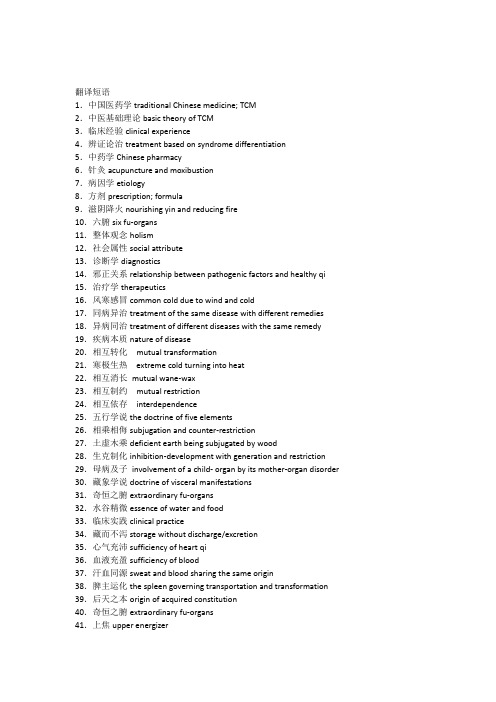
翻译短语1.中国医药学traditional Chinese medicine; TCM2.中医基础理论basic theory of TCM3.临床经验clinical experience4.辨证论治treatment based on syndrome differentiation5.中药学Chinese pharmacy6.针灸acupuncture and moxibustion7.病因学etiology8.方剂prescription; formula9.滋阴降火nourishing yin and reducing fire10.六腑six fu-organs11.整体观念holism12.社会属性social attribute13.诊断学diagnostics14.邪正关系relationship between pathogenic factors and healthy qi 15.治疗学therapeutics16.风寒感冒common cold due to wind and cold17.同病异治treatment of the same disease with different remedies 18.异病同治treatment of different diseases with the same remedy 19.疾病本质nature of disease20.相互转化mutual transformation21.寒极生热extreme cold turning into heat22.相互消长mutual wane-wax23.相互制约mutual restriction24.相互依存interdependence25.五行学说the doctrine of five elements26.相乘相侮subjugation and counter-restriction27.土虚木乘deficient earth being subjugated by wood28.生克制化inhibition-development with generation and restriction 29.母病及子involvement of a child- organ by its mother-organ disorder 30.藏象学说doctrine of visceral manifestations31.奇恒之腑extraordinary fu-organs32.水谷精微essence of water and food33.临床实践clinical practice34.藏而不泻storage without discharge/excretion35.心气充沛sufficiency of heart qi36.血液充盈sufficiency of blood37.汗血同源sweat and blood sharing the same origin38.脾主运化the spleen governing transportation and transformation 39.后天之本origin of acquired constitution40.奇恒之腑extraordinary fu-organs41.上焦upper energizer42.泌别清浊separating the lucid from the turbid43.初步消化primary digestion44.月经来潮occurrence of menstruation45.先天禀赋innateness46.水液代谢water metabolism47.气机调畅smoothness of qi movement48.气机qi movement49.气化qi transformation50.先天之气innate qi51.后天之气acquired qi52.气生血qi generating blood53.气行血qi propelling blood54.津血同源body fluid and blood sharing the same origin55.气为血帅,血为气母Qi serves as commander of blood and blood does as mother of qi 56.益气固脱nourishing qi to stop collapse57.经络学说meridian theory58.经络系统meridian system59.十二正经twelve regular meridians60.奇经八脉eight extraordinary meridians61.十二经别twelve meridians’divergences62.外感六淫six exogenous pathogenic factors63.风邪外袭pathogenic wind attacking the exterior64.感受寒邪attack/invade by pathogenic cold65.阴虚生内热production of endogenous heat due to yin deficiency66.七情内伤internal impairment due to seven emotions67.体质强弱(body )constitutional state68.五心烦热feverish sensation in the five centers (palms, soles, and chest)69.五志过极extreme changes of five emotions70.阴阳互损mutual involvement of yin and yang71.精充气足sufficient essence and abundant qi72.肌肤甲错squamous and dry skin73.预后良好favorable prognosis74.脉象pulse conations75.表里同病disease involving both exterior and interior76.寒热错杂co-existence of cold and heat/ mixture of cold and heat77.真寒假热true cold with false heat78.寒证化热cold syndrome transforming into heat one79.热证转寒transformation of heat syndrome into cold one80.潮热盗汗tidal fever and night sweating81.中草药Chinese medicinal herbs82.四气五味four properties and five flavors83.燥湿健脾drying dampness to invigorate the spleen84.升降沉浮ascending, descending, sinking and floating85.归经channel tropism of medicines86.用药禁忌medication contraindication87.方剂学science of prescription88.方剂的加减modification of a prescription89.剂型与剂量drug form and dosage90.药物毒性toxicity of medicinal herb91.引经报使guiding action92.药物饮片herbal slice93.针灸疗法acupuncture and moxibustion (therapy)94.针刺补泻reinforcing and reducing95针刺止痛analgesia by acupuncture96.针刺麻醉acupuncture anesthesia97.耳针疗法ear acupuncture (therapy)98.提插捻转lifting, thrusting, twisting and rotating (techniques)翻译句子1.中国医药学有数千年的历史,是中国人民长期同疾病作斗争的经验总结。
《中医英语听说教程1》unit7

中医英语听说教程1 Unit7一、课程简介本单元主要讲述了中医领域中的常用词汇,以及如何进行简单的对话和表达。
通过学习本单元,你将能够更好地理解和应用中医英语。
二、词汇学习在中医领域中,有许多常用的词汇。
以下是一些常见的中医词汇:1.按摩(ànmó)- massage2.针灸(zhēnjiǔ)- acupuncture3.草药(cǎoyào)- herbal medicine4.推拿(tuīná)- manipulative therapy5.中药(zhōngyào)- traditional Chinese medicine6.脉搏(màibó)- pulse7.骨折(gǔzhé)- fracture8.华佗(huátuó)- Hua Tuo (a famous physician inancient China)三、对话练习在中医场景中,进行对话和表达是非常重要的。
以下是一段简单的对话:A: 你好!我有些脸部疼痛,你能帮我吗?B: 当然!您可以尝试一下按摩,对缓解脸部疼痛有很好的效果。
A: 按摩需要多长时间?B: 一般来说,每次按摩需要大约15-20分钟。
A: 这样听起来不错。
我应该如何开始?B: 您可以先洗手,然后用手指在脸部轻轻按摩。
记得用适当的力度和频率。
A: 谢谢!我会试试看的。
在这段对话中,我们学习到了一些常见的中医表达方式。
对话也给出了一些对治疗的建议。
四、语法重点在中医英语中,一些重要的语法结构也值得学习。
以下是一些常见的语法重点:1.问句:用疑问词开头,如:What, How等。
2.祈使句:直接表达命令、请求和建议,如:Try,Wash等。
3.动词的时态变化:根据具体情况,动词的时态会发生变化,如:进行时、一般过去时等。
五、练习题目1.用英语表达以下短语:–推拿–针灸–按摩–草药2.将以下句子改为祈使句:–你可以试试按摩。
中医基础理论专业英语PPT课件
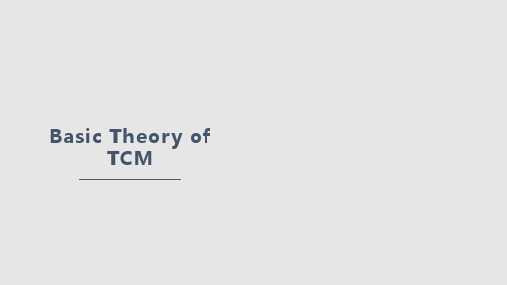
Basic Character
• treatment based on syndrome differentiation
syndrome: the pathogenesis behind a series of symptoms and signs shown outwardly (cause, location, property, tendency)
The Four Traditional Diagnostic Methods
Inspection Inquiry
Olfaction Pulse-taking
Classic Works
• Huangdi’s Canon of Medicine / Huangdi’s Internal Classic
inside
outside
Basic Character
• holism
2. unity of human and nature (correspondence between nature and human)
inadaptation to new environment
Epistaxis usually happens in springtime. Thoracic and hypochondriac diseases usually happen in summertime. Diarrhea and cold stroke usually happen in late summer. Wind malaria usually happens in fall. Arthralgia and syncope usually happen in wintertime.
Zhang Zhongjing
基础中医英语复习要点.doc
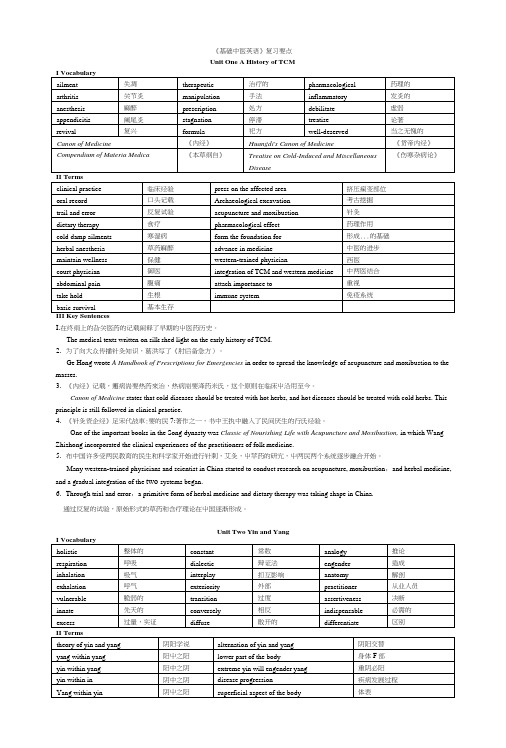
《基础中医英语》复习要点Unit One A History of TCMI.在终绢上的旮关医药的记载闹释了早期的屮医药历史。
The medical texts written on silk shed light on the early history of TCM. 2. 为了向大众传播针灸知识,葛洪写了《肘后备急方)。
Ge Hong wrote A Handbook of Prescriptions for Emergencies in order to spread the knowledge of acupuncture and moxibustion to the masses.3. 《内经》记载,邂病耑要热药來治,热病耑要洚药米氏,这个原则在临床屮沿用至今。
Canon of Medicine states that cold diseases should be treated with hot herbs, and hot diseases should be treated with cold herbs. This principle is still followed in clinical practice.4. 《针灸资企经》足宋代敁車:要的民7:著作之一,书中王执中融入了民间厌生的行氏经验。
One of the important books in the Song dynasty was Classic of Nourishing Life with Acupuncture and Moxibustion, in which Wang Zhizhong incorporated the clinical experiences of the practitioners of folk medicine.5.布中国许多受两民教育的民生和科学家开始进行针刺,艾灸,屮苹药的研宄,屮两民两个系统逐步融合开始。
中医学英文版课件:07 诊法英文班
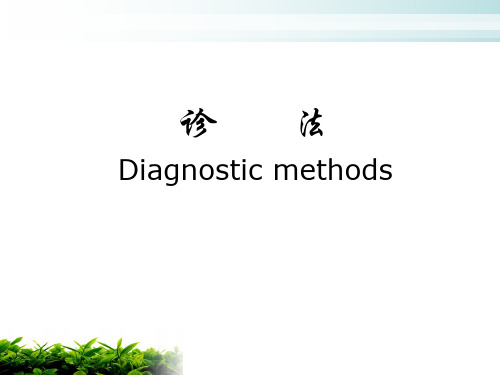
问诊
3、问痛(性质、部位) 部位 头痛 胸痛 胁痛 胃脘痛 腹痛 腰痛 四肢酸痛 周身痛
问诊
4、问饮食口味(食欲和食量、口渴、口味) 5、问睡眠(失眠、嗜睡) 6、问二便 7、问小儿 8、问经带(期、量、色、质)
脉诊pulse-taking
脉诊是最具中医特色的切诊内容
心
脉
肺
心主血脉 肺朝百脉
脾
神志言语 双目 面色 饮食
望神
有神:表明正气尚足,脏腑功能未衰,预后良好。 少神:表明正气已伤,脏腑功能不足,多见于虚证。 失神:表明正气大伤,脏腑功能虚衰,病情严重,
预后较差。 假神:表示病情恶化,脏腑精气将绝,预后不良。
也称“回光返照”、“残灯复明”。
望 色inspection of complexion
望头面、五官
inspection of head , hair and five sense organs
头部过大 过小---肾精不足insufficiency of Kidney essence 囟门 面肿 腮肿 口眼歪斜 头发
望头面、五官
inspection of head , hair and five sense organs
望 痈carbuncle疽phlegmon疔boil疖furuncle
望 排泄物
寒证 or 热证 清晰,色白 黄稠,粘
whitish or light-colored and thin excreta----cold syndrome asthenia syndrome
yellowish or deep-colored and thick excreta----heat and sthenia syndrome
中医英语lesson 1
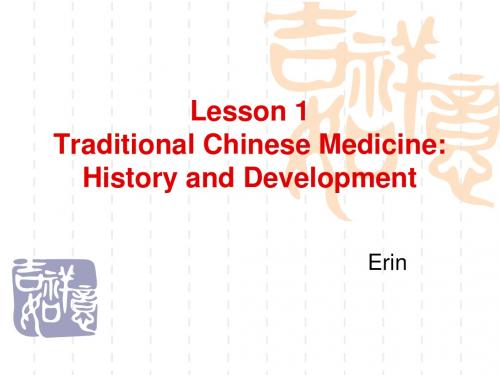
13.emergency[i'mə:dʒənsi] 急诊 room dept. 14.gynecology[,ɡaini'kɔlədʒi] 妇科学 15.obstetrics[ɔb'stetriks] 产科学 16.pediatrics[,pi:di'ætriks] 儿科学 17对 18.exogenous[ek„sɔdʒənəs] 外因的 endogenous[en'dɔdʒənəs] 内因的 19.diaphoresis[,daiəfə'ri:sis] 发汗 sweat流汗, 使流汗 perspire流汗,分泌
5.《难经》在许多方面,尤其在脉学上,补充了 《黄帝内经》的不足。 (Classic of Difficulties) has supplemented what was unaddressed in (Yellow Emperor‟s Canon of Medicine) in many respects, especially in pulse lore. 6.《诸病源候论》是中医学最早的一部病因症候 学专著。 (Treatise on the Causes and Manifestations of Various Diseases )is the earliest extant monograph on etiology and symptomatology in China.
11.下法 purgation 12.吐法 emesis ; vomiting therapy; emetic therapy 13.补土派 the School of Reinforcing the Earth 14.病因学 etiology 15.方剂 prescription; formula
- 1、下载文档前请自行甄别文档内容的完整性,平台不提供额外的编辑、内容补充、找答案等附加服务。
- 2、"仅部分预览"的文档,不可在线预览部分如存在完整性等问题,可反馈申请退款(可完整预览的文档不适用该条件!)。
- 3、如文档侵犯您的权益,请联系客服反馈,我们会尽快为您处理(人工客服工作时间:9:00-18:30)。
中医学英文词汇一、绪论中医学TCM(Traditional Chinese Medicine),中医学理论体系的形成Origination of TCM, 形成formation, 发展development 中医学理论体系的基本特点The basic characteristic of Traditional Chinese Medicine theory整体观the whole concept, 辨证论治syndrome differentiation and treatment第一章阴阳五行学说阴阳Yin-yang , 阴阳的特性the property of yin-yang阴阳之间的相互关系Interaction between yin and yang阴阳对立制约 Opposition of yin and yang阴阳互根互用 Interdependence between yin and yang阴阳消长平衡 Wane and Wax between yin and yang阴阳相互转化 Mutual transformation between yin and yang阴阳学说在中医学中的应用The applications of the theory of yin-yang in TCM说明人体的组织结构Explanation of the histological structure of the human body 解释人体的生理功能Explanation of the physiology function activity of the human body阐释病理变化Explanation of pathogenesis阴阳偏盛Relative predominance of yin or yang阳偏盛Relative predominance of yang阴偏盛Relative predominance of yin阴阳偏衰Relative decline of yin or yang阳偏衰Relative decline of yang阴偏衰Relative decline of yin五行the five elements,五行特性the five elements property第二章中医学的生理观藏象“Zangxiang” ,五脏five Zang-organs, 六腑six fu-organs,生理功能the physiological functions , 气qi, 血blood , 津液body fluid,气的生成、运动和分类the production ,moving and classification of qi,血的生成和运行the production and circulation of blood津液的生成、输布和排泄the production and transportation and metabolism of body fluid.气、血、津液的功能The physiological functions of qi, blood and body fluid心The heart,主血脉Governing blood主神志controlling the mind在体合脉governs the vessels开窍于舌opens into the tongue其华在面External manifestation on the face肝 The liver,主疏泄 To dredge and regulate, 主藏血Storing blood在体合筋The liver governing the tendons其华在爪The external manifestation of the liver on the nails开窍于目The liver opening into the eyes脾 the spleen,主运化 To govern the transportation and transformation主统血 To command blood, 主升elevating在体合肌肉,主四肢the spleen governing the muscles and the four limbs开窍于口The spleen opening into the mouth其华在唇The external manifestation on the lip肺 The lung,主气,司呼吸Dominating qi,controlling the respiratory movement主宣发、肃降dispersing and descending通调水道The regulation of water passage朝百脉、主治节‘the lung is connected with all the vessels, regulation the qi activity in the whole body在体合皮the lung governing the skin其华在毛Eexternal manifestation on the body hair开窍于鼻The lung opening into the nose肾The kidney,藏精 store essence, 主水 To govern water, 主纳气 To govern reception of qi在体合骨The kidney governing the bones开窍于耳及二阴The kidney opening into the ears, the external genitals and the anus 其华在发External manifestation on the hair胆The gallbladder, 贮藏和排泄胆汁 store and excrete the bile胃The stomach, 受纳、腐熟水谷 receive and digest food主通降‘the stomach functions to descend’,‘unobstructed condition小肠The small intestine, 受盛化物To receive the chime and transform泌别清浊 To separate the lucid from the turbid大肠The large intestine, 主传化糟粕transmitting and excreting the waste of food 膀胱The bladder ,storing and discharging urine气的生成The production of qi气的运动 The moving of qi气的功能The physiological functions of qi推动作用Propelling function温煦作用Warming function防御作用 Protecting and defencive function固摄作用 Fixating function气化作用 Qi-transforming function元气 primordial qi, 宗气 pectoral qi, 营气 nutrient-qi, 卫气 defensive qi第三章中医学的病理观病因 Causes of disease病因的概念及分类concept, classification of causes of disease.六淫的概念concept of six pathogenic factors;,,六淫致病的共同特点the general pathogenic characters of six pathogenic factors; 六淫(风、寒、暑、湿、燥、火)的性质与致病特点nature, pathogenic characters of every six pathogenic factors(including wind, cold,Summer-heat,Dampness,Dryness,Heat (fire))主要的临床表现main clinic manifestations风Wind其性开泄,易袭阳位Wind tend to float, disperse, go upward attack the upper and outside parts风性善行而数变wind tends to move and change风为百病之长,易夹杂其他外感之邪Wind tends to be complicated by other pathogenic factors寒Cold易伤阳气Cold tends to impair yang寒性凝滞Cold tends to coagulate寒性收引Cold tends to contract暑Summer-heat其性炎热Summer-heat is hot暑性升散,耗气伤津Summer-heat tends to disperse and elevate,consume the qi and body fluid暑多夹湿Summer-heat often complicated by dampness湿 Dampness湿性重浊dampness is heavy and turbid湿易阻遏气机dampness tends to block qi湿性黏滞dampness is sticky and stagnant湿性趋下, 易袭阴位dampness tends to move downward,attack the lower and inside parts燥 Dryness燥易伤津Dryness consume the body fluid燥性干涩Dryness is xerotic and unsmooth燥易伤肺Dryness tends to impair the lung火 Heat (fire)其性炎上Heat(fire) tends to flame up易伤津耗气Heat(fire) tends to consume qi and impair body fluid易生风动血Heat(fire) tends to produce wind and disturb blood易致肿疡Heat(fire) tends to cause swelling and ulceration七情内伤的概念、The concept of internal impairment due to the seven emotions, 七情致病的特点the pathogenic characters of the seven emotions痰饮、瘀血的概念、形成及致病特点The basic concept, the formation and the pathogenic characteristics of phlegm ,rheum and blood stasis痰饮phlegm ,rheum 瘀血blood stasis发病的基本原理The pathogenesis of occurrence of disease in TCM病机的概念,The concept of mechanism of pathological changes;病机the mechanism of pathological changes;邪正盛衰predomination and decline of pathogenic factors and healthy qi;阴阳失调imbalance between yin and yang;气血津液失常disorder of qi, blood and body fluid.第四章中医诊断疾病的方法中医诊法The concept of the TCM diagnostic methods中医诊断的理论依据the theory foundation of the TCM diagnostic methods.望神Inspection of spirit, 望色Inspection of complexion, 望排出物Inspection of excreta ,望舌Inspection of tongue,Existence of spirit (得神),Lack of spirit(少神),Loss of spirit (失神)False spirit(假神)Normal complexion 常色Morbid complexion 病色Red colour ,White colour ,Yellow colour, Bluish colour,Blackish colour 临床意义clinical significance ;望舌的方法Methods for inspection of tongue舌苔 tongue coat舌红 red tongue淡白舌/舌淡 Light-whitish tongue青紫舌 Cyanotic and purplish tongue问诊inquiry, 主诉chief complaint, 病史history of present illness 问现在症inquiry of the present symptomsAversion to cold and fever(恶寒发热)Cold sensation without fever(但寒不热)Fever without cold sensation(但热不寒)Alternate cold and fever(寒热往来)诊脉的部位与方法The Regions and methods for taking pulse脉诊taking pulse, 正常脉象normal pulseCunkou(寸口)cun(寸), guan(关),chi(尺).辨证的概念The concept of differentiation of syndrome表里辨证External and internal differentiation of syndromes,表证External syndromes,里证internal syndromes,寒热辨证cold and heat differentiation of syndromes,寒证cold f syndromes,热证heat syndromes,虚实辨证asthenia and sthenia differentiation of Syndromes,虚证asthenia Syndromes,实证sthenia Syndromes,临床特点clinical character and difference.八纲辨证Syndromes differentiation with eight principles气血津液辨证syndrome differentiation with qi, blood and body fluid,第五章中医学的防治原则治则therapeutic principles , 治法therapeutic methods正治Routine treatment , 反治Contrary treatment,治本treat “ben”(deal with the root cause)治标Treating biao(acute symptoms bring on great suffering to the patients, or threaten life or tend to transmit and change) in emergency ,扶正与祛邪Strengthening healthy qi and eliminating pathogenic factors,调整阴阳Regulation of yin and yang,三因制宜Abidance by individuality, locality and seasons.第六章中药基本知识中药Chinese Medicinal Herbs四气four properties、寒热温凉cold, hot, warm, cool五味five flavors、辛、甘、酸、苦、咸pungent, sweet, sour, bitter and salty. 升降浮沉the action of lifting, lowering, floating and sinking,、归经channel tropism、毒性toxicity中药的配伍、用药禁忌Contraindication and Compatibility of Chinese Medicinal Herbs中药的剂量Dosage of Chinese Medicinal Herbs第七章方剂基本知识方剂的组成原则The principle of the composition of prescriptions,Monarch drug (jun) 君Minister drug (chen) 臣Adjuvant drug (zuo) 佐Guide drug (shi) 使组成变化the modification of the composition of a prescription.方剂的组成、用法、功效、临床应用、方解: Ingredients, administration, function,clinical application and elucidation of the prescriptions第二章中医学的生理观第三节经络经络the meridians;十二经脉twelve regular meridians十二经脉走向与交接规律direction, joint law of the twelve channels、十二经脉循行分布规律distributing law of the twelve channels ,十二经脉表里络属关系exterior-interior relationship of the twelve channels ,十二经脉流注方向和次序等flowing direction and order of the twelve channels;第八章针灸学基本知识第二节刺灸方法刺法(针法)Acupuncture techniques; 进针Needling methods (insertion methods, Needling manipulation methods)得气arrival of Qi针刺意外和防治处理Management of possible accidents (emphasize 晕针fainting) 灸法moxibustion,第八章针灸学基本知识第一节腧穴腧穴概念;腧穴分类;腧穴定位方法;腧穴的作用the point/acupoint (definition/concept, classification, location method, function)腧穴的定位、归经、基本主治功能:location, channel tropism and the basic special treatment function of the point/acupoint下列腧穴的定位、基本主治功能:手太阴肺经:列缺;The lung channel of Hand-Taiyin: LieQue (Lu7)手阳明大肠经:合谷;The large intestine channel of Hand-Yangming: Hegu (LI4) 足阳明胃经:足三里;The stomach channel of Foot-Yangming: Zusanli (ST36) 足太阴脾经:三阴交;The spleen channel of Foot-Taiyin: Sanyinjiao (SP6)手少阴心经:神门;The heart channel of Hand-shaoyin: Shenmen (HT7)手太阳小肠经:听宫;The small intestine channel of Hand-taiyang: Tinggong (SI19)足太阳膀胱经:委中;The urinary Bladder channel of Foot-Taiyang: Weizhong(BL40),足少阴肾经:涌泉;The Kidney channel of Foot-shaoyin: Yongquan(KI 1)手厥阴心包经:内关;The Pericardium channel of hand-Jueyin: Neiguan (PC6) 手少阳三焦经:外关;The triple warmer (Sanjiao ) channel of Hand-Shaoyang: Waiguan (SJ5 ),足少阳胆经:风池;The Gall Bladder channel of Foot-shaoyang: Fengchi (GB20) 足厥阴肝经:太冲;The Liver channel of Foot-Jueyin: Taichong (LR3)任脉:关元、膻中;The Ren channel :Guanyuan (RN4), Tanzhong (RN17)督脉:大椎、人中;The Du channel : Mingmen(GV 4), Dazhui (DU14), Shuigou (DU26),经外奇穴:印堂、太阳;Extraordinary acupoints: Yintang(EX-HN 3),Taiyang(EX-HN 5)。
